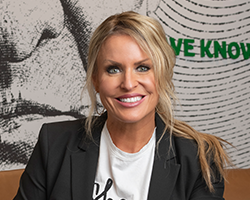As more community banks consider whether to offer artificial intelligence-powered services, Wausau, Wis.-based IncredibleBank is providing one template for success.
The $1.9 billion bank recently partnered with Jack Henry and Google to unveil an AI-powered mobile chatbot. The chatbot was expected to be available for IncredibleBank’s customer base of 42,000 households and 37,000 mobile users last month.
The chatbot doesn’t share customer information, but instead guides customers through everyday tasks such as turning a debit card on or off or changing an email address on file. CEO Todd Nagel expects the offering will provide customers with faster service while allowing existing staff to focus on more time-consuming tasks. The project is IncredibleBank’s first in the AI space.
Nagel isn’t aware of a similarly-sized bank with a comparable offering. “It’s going to be a gamechanger,” he added. “This makes us level with big banks. Big banks are using artificial intelligence; they are spending billions of dollars. We’ve got Google. They’re not using Google. Google is the preeminent creator-designer of artificial intelligence in the world, and so now that they are partnering with us, we will beat Chase, we will beat Wells Fargo, we will beat Citi — because they aren’t using Google.”

Eight years ago, IncredibleBank leaders decided that if they were going to survive in the tech-heavy world of the future, they were going to have to have a more robust relationship with Jack Henry. In the coming years, the bank secured the support of key customers to be a leader in emerging technology and offered to be a beta tester for Jack Henry’s technology offerings.
“For community banks, I’m super-excited, because if they are using a chat function, it is going to help them deliver better customer service, and I’m a big, big proponent of all community banks,” Nagel added. “We don’t consider them competitors. We consider them peers, allies.”
Complementary usage
IncredibleBank’s AI work touches on many of the key recommendations consultants have for banks entering the space, including using it only to supplement existing offerings, working with reliable third-party providers and securing the buy-in of key customers before moving forward.
AI technology simulates human intelligence using computer systems powered by advanced machine learning algorithms. Generative AI technology also creates new data similar to human-related content.
Katie Quilligan with BankTech Ventures views AI as a proactive research tool for banks to decide where to invest their money. Quilligan noted that after analyzing data, AI can create and push out personalized marketing campaigns either through email or a bank app. Some banks are already using the technology to generate first drafts of marketing copy.
Quilligan said bankers who want to use their own data to train AI must have specific, living data policies, especially for cross-departmental uses. To prepare to unveil the technology, bank marketers can give AI platforms such as ChatGPT a generic prompt to generate draft emails for internal and external shareholders. Becoming up-to-date on AI can ensure a bank is ready to use the technology as updates become available.

Quilligan said a lack of customer buy-in could pose barriers to adopting AI. To overcome any hesitancy, she said banks must ensure that the technology only enables a high-touch environment and only supplements traditional offerings. Customers must still be able to speak to a human on demand.
Speaking in early October at the Bank Holding Company Association’s fall seminar in Edina, Minn., Quilligan urged bankers to view AI as a digital intern that can identify customers who are on the verge of either pulling their accounts or becoming delinquent, or handle rules-based tasks such as data entry, data extraction and form filling. She expects the next generation of AI will be able to handle unstructured data or more complex outputs.
Nagel said AI will be able to handle 70 percent of IncredibleBank’s approximately 1,300 monthly customer service chats, which frees employees to answer potentially more significant calls and increases the number of overall calls the bank can take.
“It’s not about replacing employees, it’s about answering questions that you don’t need an employee for,” Nagel noted.
Balancing pros and cons
AI carries both numerous opportunities and risks for community banks, especially if the technology is not deployed transparently or robustly, noted Laura Kornhauser, CEO and co-founder of New York City-based predictive analytics platform Stratyfy.
Kornhauser said community banks have a well-founded apprehension to adopt the technology for uses other than chatbots and process automation because of those risks. Still, she said successfully adopting the technology for more robust tasks such as risk decision-making is possible by undertaking extensive due diligence, including understanding the different types of AI/generative AI and which form best suits the bank.
AI helps banks secure efficiency gains from handling routine tasks that can be taken care of through automation, she said. Moving forward, she sees AI as eventually allowing for forward-looking borrower risk assessments. Kornhauser said that task can be accomplished on a purely anonymized basis without disclosing personally identifiable information.
Currently, community banks use more traditional methods to identify credit risk. Kornhauser said that approach is costing community banks lending opportunities. She said by adopting AI technology, banks can approve more loans while seeing a slight decrease in default rate.
Winthrop & Weinstine community banking attorney Tony Moch said banks are interested in AI-powered data protection and analysis services as well as how the technology can help them comply with anti-money-laundering and know-your-customer requirements.
To Moch, executives at small and mid-sized banks must consider their AI-related governance and risk management strategies. He expects regulatory pressure will grow as rulemakers continue to catch up to the latest developments in AI.
Tool of the future
Kelly Brown, CEO at Midwest-based deposit management services firm Ampersand, said banks are generally not disclosing their AI offerings. Still, there are a few known key players, including several banks in Tennessee and New York. “These banks are holding it to the vest a little bit, and not wanting to share a lot,” she added. “Everyone’s trying to figure out how to be different in the banking industry now, because there’s so much change happening so quickly.”
Brown sees community banks’ adoption of AI as imperative for the industry’s survival. To her, the technology is most promising for its potential to reduce regulatory and cybersecurity compliance expenses, especially as those costs continue to disproportionately burden smaller banks.

“It’s just going to be part of our everyday language and usage as consumers, and I think that it’s going to naturally make its progression into the banking industry and just be part of the day-to-day operations,” Brown added.
Generative AI is also drawing attention. The technology is capable of creating text and images using generative models. Wipfli Senior Manager Billy Collins expects generative AI to create “a technological revolution” in consumer and commercial banking. Collins said the technology will allow banks to review large swaths of consumer data to identify trends and preferences and offer improved customer service as generative AI-powered chatbots can provide 24/7 support.
“Financial institutions that embrace generative AI have the opportunity to enhance customer experience, automate processes, improve decision-making and strengthen security measures,” Collins added. “And when combined with human expertise, generative AI can help financial institutions unlock new possibilities and drive innovation in the industry.”
Nearly half of bank executives are implementing generative AI solutions, according to a June 2023 survey from accounting firm KPMG. Sixty-nine percent identified generative AI privacy concerns as a high priority in June, up from 56 percent earlier in the year.
Executives identified fraud detection and prevention as the No. 1 application for generative AI in financial services. Sixty-six percent said their organization will likely use the technology to enable more advanced visual assistants and chatbots, and 62 percent expect it will be used for customer service and personalization.
One major hurdle in adopting generative AI is underdeveloped IT/digital infrastructure. According to the KPMG report, nearly 40 percent of financial services executives said their organization’s IT/digital infrastructure was either at a “low” or “medium” level of development.
‘There’s no magic bullet’
AI requires extensive supervision, regular feedback and updates. AI systems can pose bias and discrimination challenges from biased training data and flawed algorithms. If used improperly, generative AI can enable misinformation by producing real-sounding but false content.
To Kornhauser, effective machine learning can reduce bias in three ways: Uncovering bias through proactive testing, drilling down for a deeper understanding of what is driving the bias, and identifying solutions. She sees AI adoption as crucial for the survival of community banking.
“Waiting on the sidelines is not an option,” she added.
Banks must also have proper internal guidelines and protocols to ensure that their fintech partner’s use of AI meets regulatory guidelines. Brown advised banks to oversee AI systems similarly to other vendors as they bear ultimate responsibility for any third-party errors. Banks must also consider who can access sensitive data and have sufficient data backups.
“There’s no magic bullet,” Brown said of banks adopting AI. “It’s not going to be perfect, especially when AI is … newer to the banking industry. There’s going to be some trial and error. We’ve heard some of the good things that AI can do, but I think that as it grows and AI learns more, there could be some pitfalls.”
Ampersand is connecting banks with AI. In November, the Waukesha, Wis.-based firm launched a platform which allows depositors to prioritize rates, safety, or their dedication to community impact and responsibility. The platform uses AI to generate algorithms based on customer behavior, preferences and risk tolerance.
“We can use AI to provide personalized recommendations for products that actually match what their needs are,” Brown added. “It enhances the engagement and satisfaction of our clients.”
Ampersand is evaluating AI for fraud detection and to help monitor transactions and identify suspicious activities. The company plans to upload a chatbot offering for customers who have questions, to guide them through what the deposit process looks like, or to offer assistance on managing accounts.
One Ampersand investor — Nashville-based venture capital firm FINTOP Capital — invests in AI technology companies to help community banks remain relevant. Another major investor is Radnor, Pa.-based private equity firm Patriot Financial Partners. Those partnerships have introduced Ampersand to third-party AI companies that best fit its business plan.
“Ampersand’s groundbreaking technology will not only enhance the efficiency of financial institutions but also deliver top depositors the next level of transparency, service quality and results they ardently demand,” said FINTOP Capital Managing Partner Joe Maxwell.
Regulatory speedbumps
AI technology has been met with mixed regulatory feedback. Though regulators say AI can help banks reduce costs, improve efficiencies and identify potentially more complex relationships, they have also cited the operational and cyber risks posed by the technology and how it is designed, used or deployed.
In October, President Joe Biden issued a broad executive order requiring developers of the most powerful AI systems to directly share their safety test results with the government. Biden’s order also called on the Department of Homeland Security to establish an AI Safety and Security Board. The Department of Commerce is expected to develop guidance for content authentication and watermarking to clearly identify AI-generated content.
Last May, the Consumer Financial Protection Bureau cautioned banks that they could violate consumer protection laws if chatbots fail to provide accurate information to customers and don’t protect their privacy and data.
Acting Comptroller of the Currency Michael Hsu has called on banks to develop AI and tokenization in “tightly controlled stages where the risks can be identified, measured and managed at each stage,” with engagement by risk managers and compliance professionals. For Hsu, the safe development of AI is difficult because it’s generally based on computer systems modeled on the human brain and nervous system.
“The ability of AI agents to mimic human communication and the low cost of scaling AI agents increase opportunities for fraud,” Hsu said. “The speed and sophistication of such developments warrant close monitoring and coordination.”
